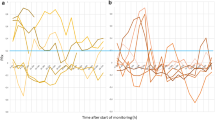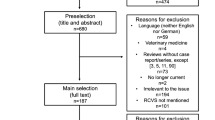Abstract
Objective
To determine the role of cerebral vasoconstriction in the delayed hypoperfusion phase in comatose patients after cardiac arrest.
Design
Prospective study.
Setting
Medical intensive care unit in a university hospital.
Patients
10 comatose patients (Glasgow Coma Score ≤6) successfully resuscitated from a cardiac arrest occurring outside the hospital.
Measurements
We measured the pulsatility index (PI) and mean blood flow velocity (MFV) of the middle cerebral artery, the cerebral oxygen extraction ratio and jugular bulb levels of endothelin, nitrate, and cGMP during the first 24 h after cardiac arrest.
Results
The PI decreased significantly from 1.86±1.02 to 1.05±0.22 (p=0.03). The MFV increased significantly from 29±10 to 62±25 cm/s (p=0.003). Cerebral oxygen extraction ratio decreased also from 0.39±0.13 to 0.24±0.11 (p=0.015). Endothelin levels were high but did not change during the study period. Nitrate levels varied widely and showed a slight but significant decrease from 37.1 μmol/l (median; 25th–75th percentiles: 26.8–61.6) to 31.3 μmol/l (22.1–39.6) (p=0.04). Cyclic guanosine monophosphate levels increased significantly from 2.95 nmol/l (median; 25th–75th percentiles: 2.48–5.43) to 7.5 nmol/l (6.2–14.0) (p=0.02).
Conclusions
We found evidence of increased cerebrovascular resistance during the first 24 h after cardiac arrest with persistent high endothelin levels, gradually decreasing nitrate levels, and gradually increasing cGMP levels. This suggests that active cerebral vasoconstriction due to an imbalance between local vasodilators and vasoconstrictors plays a role in the delayed hypoperfusion phase.
Similar content being viewed by others
References
Safar P (1993) Cerebral resuscitation after cardiac arrest: research initiatives and future directions. Ann Emerg Med 22:324–349
Beckstead JE, Tweed WA, Lee J, Mac Keen WL (1978) Cerebral blood flow and metabolism in man following cardiac arrest. Stroke 9:569–573
Forsman M, Aarseth HP, Nordby HK et al (1989) Effect of nimodipine on cerebral blood flow and cerebrospinal fluid pressure after cardiac arrest. Correlation with neurologic outcome. Anesth Analg 68:436–443
Faraci FM (1992) Regulation of the cerebral ciroulation by endothelium. Pharmacol Ther 56:1–22
van der Hoeven JG, Koning de J, Frölich M, Meinders AE (1995) Early jugular bulb endothelin levels in comatose patients who are successfully resuscitated from an out-of-hospital cardiac arrest (abstract). Crit Care Med 23 [Suppl]:A 182
Goetting MG, Preston G (1990) Jugular bulb catheterization: experience with 123 patients. Crit Care Med 18:1220–1223
Gibbs EL, Lennox WG, Gibbs FA (1945) Bilateral internal jugular blood, a comparison of A-V differences, oxygen-dextrose ratios and respiratory quotients. Am J Psychiatry 102:184–190
Shenkin HA, Harmel MH, Kety SS (1948) Dynamic anatomy of the cerebral circulation. Arch Neurol Psychiatry 60:240–252
Stocchetti N, Paparella A, Bridelli F et al (1994) Cerebral venous oxygen saturation studied with bilateral samples in the internal jugular veins. Neurosurgery 34:38–44
Wagner OF, Nowotny P, Vierhapper H (1991) Unchanged plasma concentrations of endothelin-1 in healthy men during short-term infusions of AMP, dDAVP and of norepinephrine. Horm Metab Res 23:191–192
Westendorp RJG, van der Hoeven HG, Frölich M, Meinders AE (1993) Cardiac-endothelium feedback. Lancet 342: 1121–1122
Groeneveld PHP, Colson P, Kwappenberg K, Clement J (in press) Increased production of nitric oxide (NO) in patients infected with the European variant of Hantavirus. Scand and J Infect Dis
Wennmalm Å, Benthin G, Edlund A et al (1993) Metabolism and excretion of nitric oxide in humans. An experimental and clinical study. Circ Res 73:1121–1127
Steiner AL, Parker CW, Kipnis DM (1972) Radioimmunoassay for cyclic nucleotides. I. Preparation of antibodies and iodinated cyclic nucleotides. J Biol Chem 247:1106–1113
Markwalder TM, Grolimund P, Seiler RW, Roth F, Aaslid R (1984) Dependency of blood flow velocity in the middle cerebral artery on end-tidal carbon dioxide partial pressure: a transcranial ultrasoud Doppler study. J Cereb Blood Flow Metab 4:368–372
Newell DW, Aaslid R (1992) Normal values and physiological variables. In: Transcranial Doppler. Raven Press, New York, pp 41–48
Bishop CCR, Powell S, Rutt D, Browse NL (1986) Transcranial doppler measurement of middle cerebral artery blood flow velocity: a validation study. Stroke 17:913–915
Giller CA, Hodges K, Batjer HH (1990) Transcranial doppler pulsatility in vasodilation and stenosis. J Neurosurg 72:901–906
Bacic F, Uematsu S, McCarron M et al (1992) Secretion of immunoreactive endothelin-1 by capillary and microvascular endothelium of human brain. Neurochem Res 17:699–702
Robinson MJ, Macrae IM, Todd M et al (1991) Reduction in local cerebral blood flow induced by endothelin-1 applied topically to the middle cerebral artery in the rat. J Cardiovasc Pharmacol 17 [Suppl 7]:S354-S357
Kadel KA, Heistad DD, Faraci FM (1990) Effects of endothelin on blood vessels of the brain and choroid plexus. Brain Res 518:78–82
Dietrich WD, Busto R, Yoshida S et al (1987) Histopathological and hemodynamic consequence of complete vs incomplete ischemia in the rat. J Cereb Blood Flow Metab 7:89–95
Dietrich WD, Halley M, Valdes I (1991) Interrelationships between increased vascular permeability and acute neuronal damage following temperature-controlled brain ischemia in rats. Acta Neuropathol 81:615–625
Willette RN, Zhang H, Mitchell MP et al (1994) Nonpeptide endothelin antagonist. Cerebrovascular characterization and effects on delayed cerebral vasospasm. Stroke 25:2450–2456
Faraci FM, Brian JE (1994) Nitric oxide and the cerebral circulation. Stroke 25:692–703
Moncada S, Palmer RMJ, Higgs EA (1991) Nitric oxide: physiology, pathophysiology and pharmacoloy. Pharmacol Rev 43:109–142
Nishimura H, Rosenblum WI, Nelson GH et al (1991) Agents that modify EDRF formation alter antiplatelet properties of brain arteriolar endothelium in vivo. Am J Physiol 261:H103-H107
Beckman JS, Beckman TW, Chen J, Marshall PA, Freeman BA (1990) Apparent hydroxyl radical production by peroxynitrite: implications for endothelial injury from nitric oxide and superoxide. Proc Natl Acad Sci USA 87: 1620–1624
Buisson A, Plotkine M, Boulu RG (1992) The neuroprotective effect of a nitric oxide inhibitor in a rat model of focal cerebral ischemia. Br J Pharmacol 106:766–767
Weissman BA, Kadar T, Brandeis R, Shapira S (1992) NG-Nitro-L-arginine enhances neuronal death following transient forebrain ischemia in gerbils. Neurosci Lett 146:139–142
Clavier N, Kirsch JR, Hurn PD, Traystman RJ (1994) Cerebral blood flow is reduced by Nω-nitro-L-arginine methyl ester during delayed hypoperfusion in cats. Am J Physiol 267:H174-H181
Mayhan WG, Amundsen S, Faraci FM et al (1988) Responses of cerebral arteries after ischemia and reperfusion in cats. Am J Physiol 255:H879-H884
Author information
Authors and Affiliations
Rights and permissions
About this article
Cite this article
Buunk, G., van der Hoeven, J.G., Meinders, A.E. et al. Cerebral vasoconstriction in comatose patients resuscitated from a cardiac arrest?. Intensive Care Med 22, 1191–1196 (1996). https://doi.org/10.1007/BF01709335
Received:
Accepted:
Issue Date:
DOI: https://doi.org/10.1007/BF01709335




